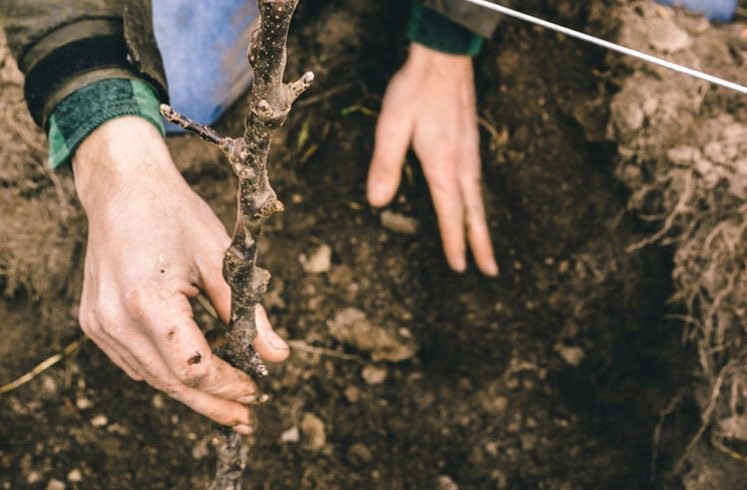Site Preparation and Planting
Once a site is selected, some preparation will need to take place before trees can be planted. How the site is prepped will depend on the length of time before trees arrive, soil depth and quality, the orchard design, and what existing vegetation is present. As with any perennial crop, it is important to plan ahead and make sure that issues like weeds, soil quality, and soil grading are done in advance of tree planting. For more details on the site preparation process, listen to the workshop presentation, "Site Preparation, Tree Planting and Care."
Before trees arrive
At a minimum, weeds should be identified and initial control steps should be taken; soil should be ripped, amended and graded; fencing, trellising and irrigation backbone should be installed; and an orchard cover crop planted. If more than one growing season will pass before trees are planted, growers might choose to plant a cover crop not only to compete with weeds and prevent soil erosion, but also to improve soil quality. A cover crop mix that includes a legume will add Nitrogen to the soil. Other highly productive plants like annual rye and buckwheat will add organic matter and compete with weeds.
Summer/Fall
Control weeds! Pay special attention to perennial weeds like quack grass and Canada thistle. If you are organic, this process will take multiple rounds of tilling and possibly multiple growing seasons integrating competitive cover crops. For conventional operations, perennial weeds can be treated with a systemic herbicide. This may also require multiple treatments. The most effective time for treating the weeds is when they are actively growing and in the fall when they will pull the herbicide into their rootsystem as they move carbohydrates for winter storage. Regardless of the methods used, controlling weeds prior to planting is essential to the success of young trees, which do not compete well with weeds for nutrients and water and are easily damaged by rodents that find cover in weeds and other vegetation close to trees. For more on weed control, listen to the workshop presentation titled, "Orchard Floor Management."
If there are restrictive layers in the soil, rip the ground to break them up and increase the rooting depth for trees.
Once perennial weeds have been initially treated, cultivate the ground and grade it to the desired slope. If soil tests indicated that soil amendments should be made to improve soil pH, organic matter, or immobile nutrients like Phosphorus, till these amendments in during cultivation.
Mark out rows and alleys and plant desired alley vegetation (permanent) and an annual cover crop (temporary) in rows. If necessary and timed correctly, there may be another opportunity to treat weeds during this process.
Install fencing, trellis posts, and any permanent irrigation infrastructure.
Spring
Terminate cover crop by tilling, herbicide, or mowing, and prepare rows for planting trees. This is your last chance to amend the soil as previously described, however soils can be difficult to work in the spring due to extra moisture, so try to avoid needing to amend or cultivate soil at this time. Plant trees as soon as the ground is workable and preferably before bud break in the spring.
Planting
Tree Storage
If possible, plant trees in early spring before bud break. Fall-planted trees are more susceptible to cold injury. Trees should be stored in a cool (34-40 degrees F) place away from ethylene and kept moist until ready to plant. Six to twelve hours before planting, soak roots in a bucket of water. Take care to protect roots of unplanted trees from direct sunlight by placing in shade or covering bucket with a cloth.
Prepare tree holes
Holes can be dug or augured. When considering using an auger, be sure to take into account your soil type. Over augering in heavy soils can lead to impermeable areas where soil has been "shined" by the auger.
Holes should be dug to only slightly deeper and wider than the root ball. This will prevent settling and glazing post planting.
Placing trees in holes
Place trees in the prepared holes allowing roots to be spread out. Do not cram roots into a too-small hole, and make sure that all roots are positioned parallel to the ground horizontally or in a downward direction to avoid suckering.
The graft union should be 2 to 3 inches above the soil line.
Fill the hole with soil and tamp down to avoid settling and air pockets. Adding water and repeating this process will ensure there is enough soil to avoid settling and poor coverage later.
Fertilize as required according to soil test. If weeds are still a problem, apply pre-emergent herbicides to soil surface.
For more detailed information on planting trees, refer to this MSU Extension article on planting apple trees.


